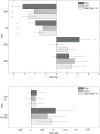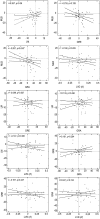Intra- and Inter-Task Reliability of Spatial Attention Measures in Pseudoneglect
- PMID: 26378925
- PMCID: PMC4574708
- DOI: 10.1371/journal.pone.0138379
Intra- and Inter-Task Reliability of Spatial Attention Measures in Pseudoneglect
Erratum in
-
Correction: Intra- and Inter-Task Reliability of Spatial Attention Measures in Pseudoneglect.PLoS One. 2018 Oct 2;13(10):e0205269. doi: 10.1371/journal.pone.0205269. eCollection 2018. PLoS One. 2018. PMID: 30278070 Free PMC article.
Abstract
Healthy young adults display a leftward asymmetry of spatial attention ("pseudoneglect") that has been measured with a wide range of different tasks. Yet at present there is a lack of systematic evidence that the tasks commonly used in research today are i) stable measures over time and ii) provide similar measures of spatial bias. Fifty right-handed young adults were tested on five tasks (manual line bisection, landmark, greyscales, gratingscales and lateralised visual detection) on two different days. All five tasks were found to be stable measures of bias over the two testing sessions, indicating that each is a reliable measure in itself. Surprisingly, no strongly significant inter-task correlations were found. However, principal component analysis revealed left-right asymmetries to be subdivided in 4 main components, namely asymmetries in size judgements (manual line bisection and landmark), luminance judgements (greyscales), stimulus detection (lateralised visual detection) and judgements of global/local features (manual line bisection and grating scales). The results align with recent research on hemispatial neglect which conceptualises the condition as multi-component rather than a single pathological deficit of spatial attention. We conclude that spatial biases in judgment of visual stimulus features in healthy adults (e.g., pseudoneglect) is also a multi-component phenomenon that may be captured by variations in task demands which engage task-dependent patterns of activation within the attention network.
Conflict of interest statement
Figures








References
-
- Wilson B, Cockburn J, Halligan P. Development of a behavioral test of visuospatial neglect. Arch Phys Med Rehab. 1987; 68(2): 98–102. - PubMed
-
- Driver J, Vuilleumier P, Husain M. Spatial neglect and extinction In: Gazzaniga M, editor. The new cognitive neuroscience III. Cambridge: MIT Press; 2004. pp. 589–606.
-
- Halligan PW, Fink GR, Marshall JC, Vallar G. Spatial cognition: evidence from visual neglect. Trends Cogn Sci. 2003; 7(3): 125–133. - PubMed
Publication types
MeSH terms
LinkOut - more resources
Full Text Sources
Other Literature Sources

